By Rob Shaul, Founder
I’ve never added up the thousands of dollars and hours we’ve spent on testing and trying different gym and fitness equipment over the years.
Purchasing and testing new gym/fitness equipment aligns with MTI’s ethic of “continuous improvement.” There is no real systematic “method” to our process. Generally, I’ll see or read about something interesting, purchase it, and design it into the next training cycle to test it out.
The true “test” is whether or not the piece of equipment stays on the gym floor or gets banished to our storage area in the attic. The stuff that stays gets used nearly every day and is durable. The equipment that gets sent to the attic is in the way – and I need the room. It’s not like I hate the stuff, it just never earns its way back into my programming and earns a spot on the weight room floor.
Below is 12 fundamental pieces of gym equipment that have earned their places on our gym floor, we use nearly every day, and have passed the test of time.
1. Barbells + Bumper/Iron Plates (Iron 5s, 10s and 2.5s)
The simple barbell and bumper plates are by far the most versatile piece of fitness training equipment we found. By varying loading and set/rep schemes, the barbell can be used for both max effort strength training and extended gym-based work capacity and endurance efforts … plus everything in between.
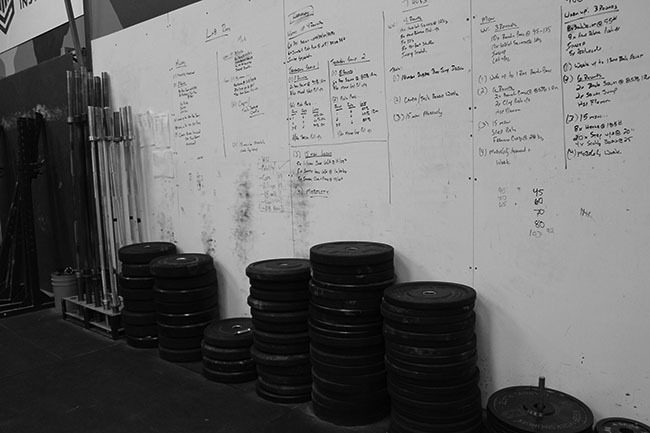
What makes the barbell so versatile is its ease of progression. I can increase the weight of a barbell by 5 pounds of a time – the smallest and easiest progression increment of any piece of equipment in the room. Dumbbells also increase by 5 pounds at a time, but this is just for one dumbbell. For two dumbbells, two hands – the total increase is 10 pounds at a time.
We use both bumper and iron plates – bumpers primarily for 45s, 25s, and 15s and a mix of bumpers and iron plates for 10s and 5s. We also have iron 2.5s.
2. Simple, Moveable, Racks
When I first started Mountain Athlete years ago, I purchased some heavy duty, $2,000 squat racks from Bigger Faster Stronger. These were the cheapest racks I could find at the time, and thank God I could drive down to the BFS warehouse in Salt Lake City (10 hour round trip) to avoid shipping costs.
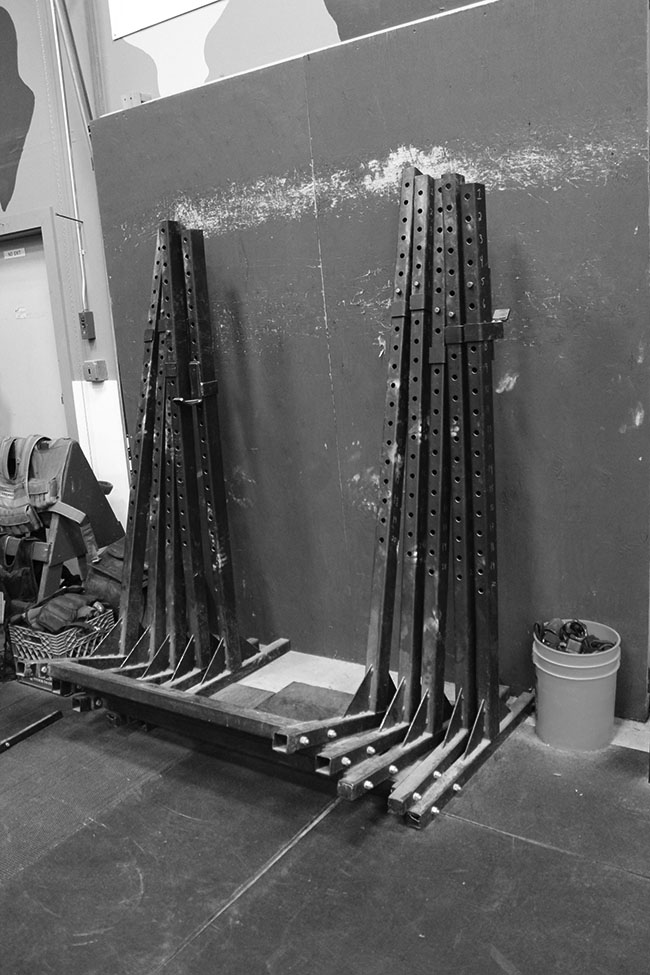
CrossFit was gaining traction during this time (2006), and the resulting explosion of garage gym brought much-needed disruption to the gym equipment industry. Before CrossFit, the number of vendors building this stuff was few and the prices big. CrossFit brought with it decreasing costs and a much greater selection.
When I moved the gym to its current location I replaced the large, stationary BFS racks with some cheap ($400/each), light, simple, moveable squat stands from Rogue Fitness and have used these daily for 8 years. Early on I learned that open space was the most valuable element of a weight room, and being able to stack our racks out of the way against the wall after use has greatly added to the versatility of my floor space.
These racks have been bomber and survived not only daily use but being moved around and stacked on top of each other.
3. Dumbbells/Kettlebells
You don’t need both – and could easily get away with one or the other. And between the two, I’ve found dumbbells not only significantly cheaper but also more versatile. But overall, dumbbells and/or kettlebells have proven to be great training tools for us.
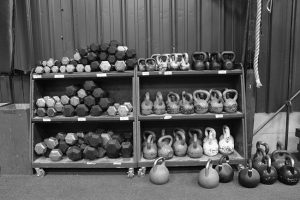
Like barbells, dumbbells/kettlebells can be used for strength, work capacity, and endurance training. Unlike barbells, they can also be used for single arm training and are a better tool for single leg training.
We don’t have full sets of each. On the dumbbell side, I have several pairs of 15s and 25s, a couple pairs each of 35s and 45s, and just one pair of 55s.
Kettlebell wise, we have four pairs each of 8kgs, 12kgs and three pairs each of 16kgs, 20kgs, and 24kgs. We have two pairs each of 28kgs and 32kgs.
For whatever reason, a pair of 45 pound dumbbells or 20kg kettlebells – both around 90 pounds total – is significantly heavier than a 90-pound barbell.
4. Sandbags
Few facilities around use sandbags to the extent we do at MTI. We use just three sandbag weights – 40 pounds, 60 pounds and 80 pounds and deploy sandbags for strength, work capacity, endurance, and chassis integrity training.
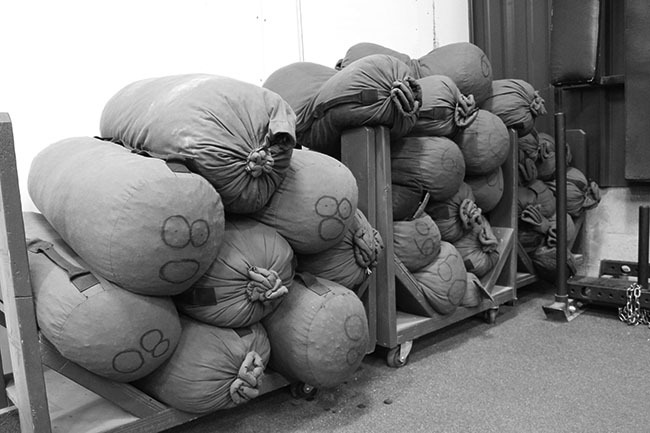
Sandbags work the midsection like no other piece of fitness equipment we own and for this reason a key part of our Chassis Integrity training methodology. Our Sandbags are custom made, and when filled with wood pellets or rubber mulch, thick and bulky. This bulk and awkwardness demand midsection work unlike a barbell or even dumbbells/kettlebells.
A main limitation of sandbags is they are difficult to progress. Unlike a barbell or set of dumbbells, I can’t easily add 5 or 10 pounds to the sandbag weight. But over the past several years, we haven’t found this to be much of a limitation. Women mostly use 40 and 60 pounds sandbags, and men use the 60 and 80 pound bags depending upon the exercise.
Over the years we’ve built and messed around with a couple of 100 pound sandbags, but honestly, this heavier load has not found its way into my programming. An 80 pound sandbag is plenty heavy for our purposes and our athlete population.
5. 20x24x30 Inch Plyo Boxes
We had our main 20x24x30 inch plyo boxes custom built years ago long before this configuration was available from equipment vendors. Ours are
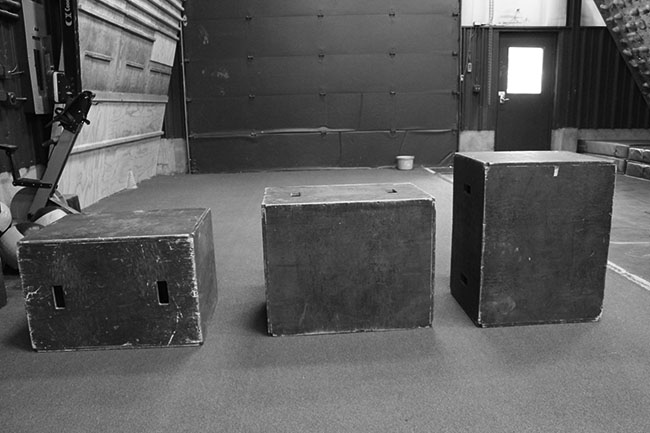
We had our 20x24x30-inch plyo box custom built years ago. They keep going and going.used for work capacity (high rep box jumps), power training (low rep, increased height box jumps), agility training, step ups (endurance), and tactical agility drills.
Even with up to 30 athletes training in the gym at a time, we’ve managed to make just four of these boxes work in our training sessions.
We store them under our pull up bars when not in use, where they serve as a step for shorter athletes. Plyo boxes are one of the most versatile and useful pieces of training equipment in our gym and used nearly every training session.
6. Step Up Benches
Our 17-inch step up benches were custom built several years ago by a couple of my professional mountain guides and are still grinding along. Every few weeks I’ll get out the drill driver and tighten up the drywall screws holding the benches together, but otherwise, these have needed no maintenance.
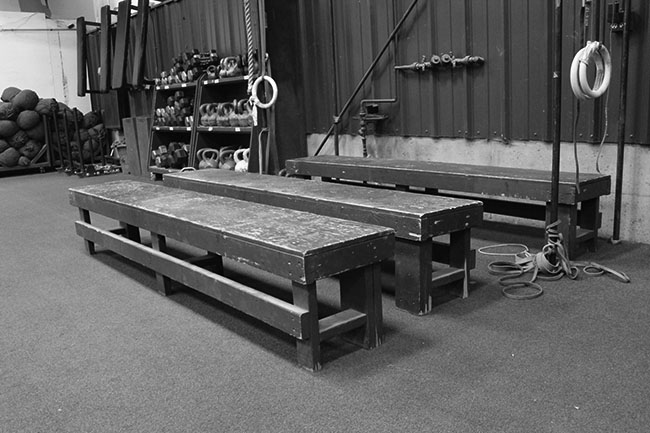
Custom built, our step up benches have lasted nearly 8 years, are 17 inches high, 8-feet long, and each holds 4 athletes.Step ups are our primary, gym-based training mode to train uphill hiking under load and the 17-inch height works best for most athletes. Our benches are 8 feet long, and we can get four athletes at a time doing step ups on each bench.
We also use them for bench dips, hippity hops, touch/jump/touch intervals, and a few other exercises, but their primary use is for step ups.
7. 25-Pound Weight Vests
Rarely do the athletes we focus on – mountain and tactical – do their sport or work unloaded. Mountain athletes usually carry a backpack and tactical athlete at minimum are wearing body armor or bunker gear, and often on the military side – a ruck as well. This is why, early on, we made weight vests a key tool in our programming.
But over the years, I’ve come to see weight vests as versatile fitness tool which can be used for strength, work capacity, and endurance training. They can turn a simple bodyweight exercise circuit into a serious, no joke, strength effort, and a 300m shuttle into a mental fitness and strength effort.
The 25-pound weight has been best for us. It’s heavy enough to make push ups, pull ups, lunges, squats and box jumps hard, but light enough to where we can still sprint, do agility work and run distance. Here are the ones we buy and use at MTI. They have been absolutely bomber.
8. Pull Up Bar
Ours is made from iron pipe and simple fittings screw together fittings. We anchored it to the floor and placed it up next to a wall to maximize open floor space. Obviously we use the bar for multiple pull up variations, but also for weighted pull ups and a handful of core exercises.
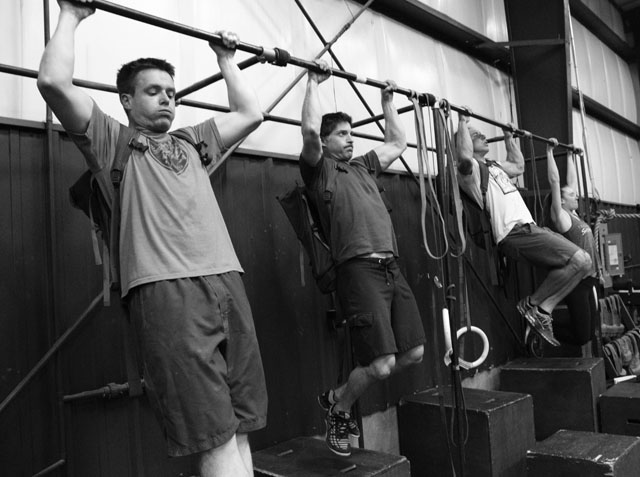 As well, we’ll connect big rubber bands to the frame for mobility and more midsection exercises, and use the frame a few select upper body stretches.
As well, we’ll connect big rubber bands to the frame for mobility and more midsection exercises, and use the frame a few select upper body stretches.
Rarely does a session go by where somewhere inside it’s programming the pull bar or frame is not used.
9. Climbing Ropes
I’m a huge fan of the simple rope climb as an upper and total body training exercise which has great transfer outside the gym. Few exercises give me stomach butterflies these days – but the rope climb is one of them. I’ll often program a rope climb as an upper body pull exercise and superset rope climbs with an upper body strength exercise in a strength circuit.
But really, the rope climb is a total body exercise given the way it often makes me and my athlete breath so hard. One of my favorite circuits ever is a Double Eagle total body strength exercise and a rope climb in the same circuit – a great, functional strength and work capacity effort.
MTI’s climbing ropes, unlike the other equipment listed here, aren’t versatile. We use them only for rope climbs – but feel I so strongly about the rope climb as an exercise, they’ve stuck.
We use 21-foot manila climbing ropes for our 18-foot high gym. They wear out near the floor and I have to replace them yearly – but still find them worth it.
10. Backpacks/Rucks
We use backpacks/rucks when we need loading lighter or heavier than our 25# weight vests. Lighter? – often needed for weighted pull ups. Heavier? Both for rucking, ruck running, and step ups.
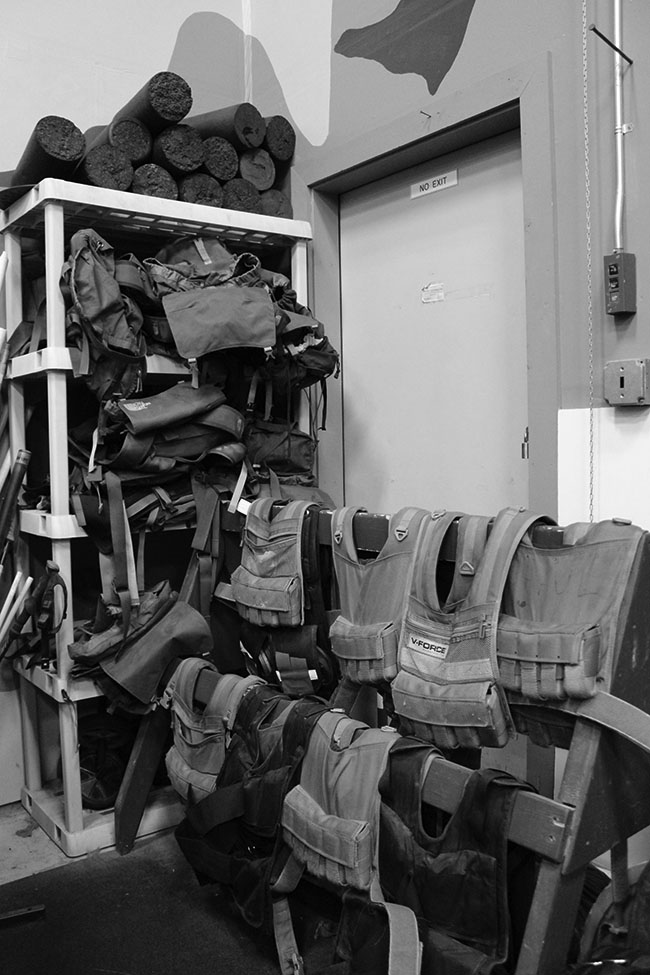
A common load for both is 40-45 pounds. Over the years we’ve cycled through several brands of backpacks. We’re hard on these – and cheaply made or super light designs don’t last. The material will tear, shoulder straps pull for the bag, or buckles break.
Our current backpacks were originally designed by The North Face as climbing rope and rack (gear) carrying pack for use by rock climbers on their short approach to a climbing crag. Because the intended traveling distance isn’t far, The North Face used heavyweight materials and straps, and these are simple and perfect for our uses. Unfortunately, The North Face doesn’t make these anymore.
For loading in the gym, we’ll use iron plates or dumbbells. We’ll stuff a foam roller or dodgeball in the bottom of the pack first, then put the plates or dumbbell on top – this avoids the load banging the athlete again and again in the low back while he/she is doing step ups or running.
For ruck running, and loads at 40+ pounds, we use contractor bags filled with sand for load. Simple and easy.
11. Programmable Interval Wall Timer

It took me a while to buy one of these large, programmable interval wall timer clocks because they seem so darn expensive for what you get. I liked the first one so much, I bought a second. Often at MTI I’ll be coaching multiple training sessions (groups of athletes training at the same time, but doing different sessions) and will have one group using one clock, and another group using the second clock.
Our clocks are from Muscle Driver and cost about $250 each. I think I bought them from amazon.com, and I know Rogue Fitness also makes one of these clocks. Ours came with a simple remote, and have proven to be bomber. We use them every single day – usually for work capacity training, but also often for our climbing work on the campus/system boards.
12. Lots and Lots of White Board Space
The entire back wall at MTI is one big whiteboard – and it’s proven to be an incredible training tool. White Boards sold by school and office supply companies are way too expensive. We bought ours from a local lumber shop – the stuff is called “Melamine” and you can pick up 4×8 sheets for under $20/each. When traveling to teach programming courses, I’ll often stop by Home Depot or Lowes and buy some there. Again – something we use every day.
Honorable Mentions
The following equipment has also proven itself over the test of time, but it’s not stuff we use every day.
Turf
I had a 12×40 piece of turf put in the gym about 5 years ago. I ordered it from a turf company online, and it is so heavy on its own, I didn’t need to glue it down. While not essential – our strip of turf gets plenty of use for sandbag get ups, shuttle sprints, plyo work, agility work, etc.
Flat Benches
The bench press exercise is a key upper body pressing exercise in MTI’s program design. We picked up 4 benches for about $150/each and use them with racks for not only bench presses, but also incline bench presses (we put 1 end of the bench on a small plyo box). We can also use them for step ups and hippity hops.
Sleds
We have two sleds we use for work capacity and strength work. These are great training tools – but we simply don’t have the space, and enough of them to use every day. Plus, they can be expensive. Ours are from Rogue Fitness.
Foam Rollers
All my athletes like to foam roll – and do it on their own before or after training or both. I have no idea why simple foam rollers are so expensive. I “cheat” and buy 3-foot long foam rollers, then use a big kitchen knife to cut them into 1-foot lengths. No one has complained yet about using these shorter rollers.
Small Plyo Boxes
We have four 15×20-inch custom-built plyo boxes and often use the 15-inch height for box jumps and step ups for older/weaker/injured athletes. Also – we use the 15″ height for Box Squats.
Lifting Chains
From time to time we’ll use lifting chains on barbells for squatting exercises (front, back) and benching exercises (bench, incline). I purchased a long piece of chain from an industrial supply warehouse and had a welder cut it into lengths for me. Chains are used for “accommodating resistance.” We all know that near the top of a squat or bench press moving the barbell gets easier. With the chains on the barbell, however the higher the barbell moves up off of the ground the more chain is lifted off the floor and the heavier the barbell gets – the idea is to work the muscles all the way through the full range of motion of the exercise.
Questions, Feedback, Comments? Email coach@mtntactical.com
You Might Also Like How We’ve Built Our Programming From The Ground Up
